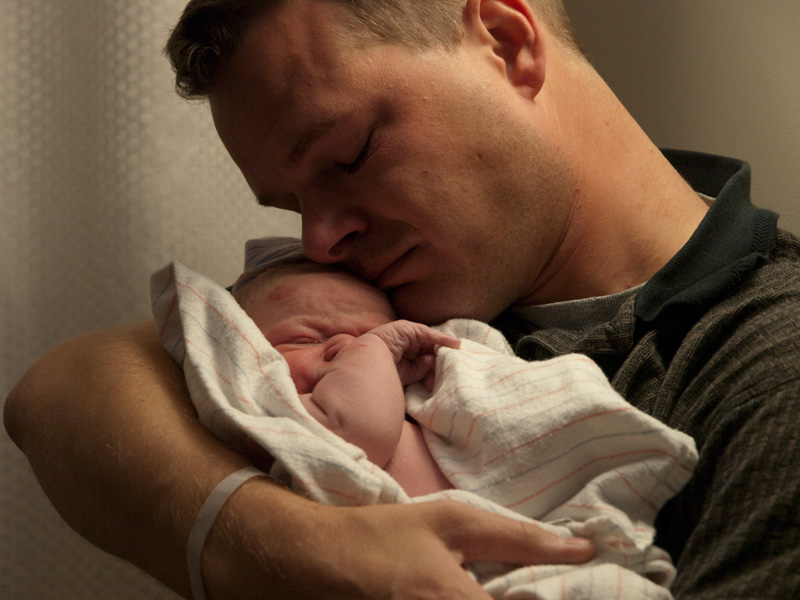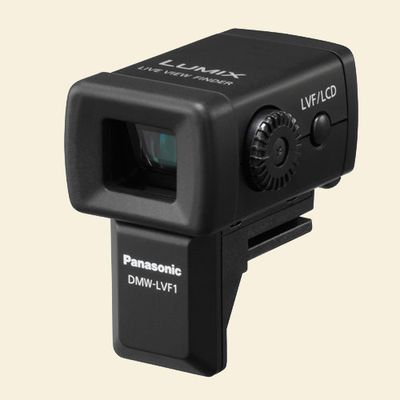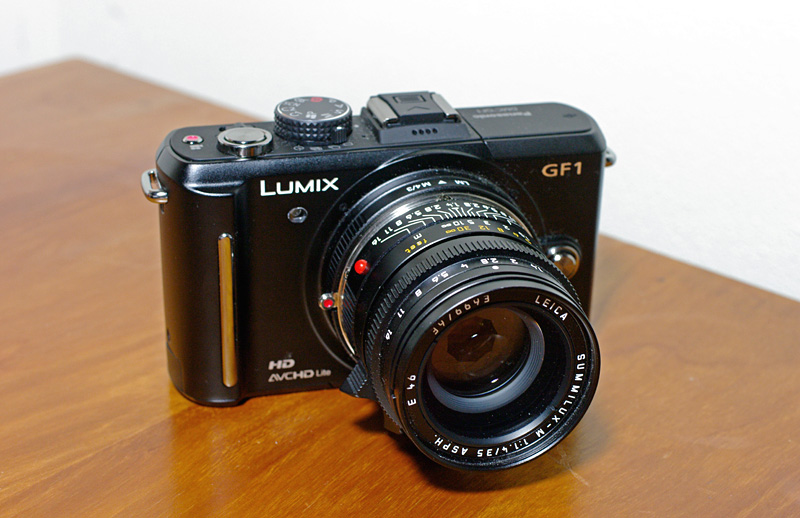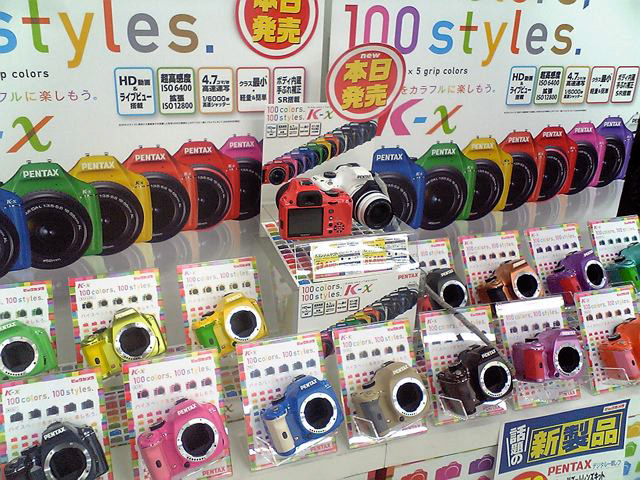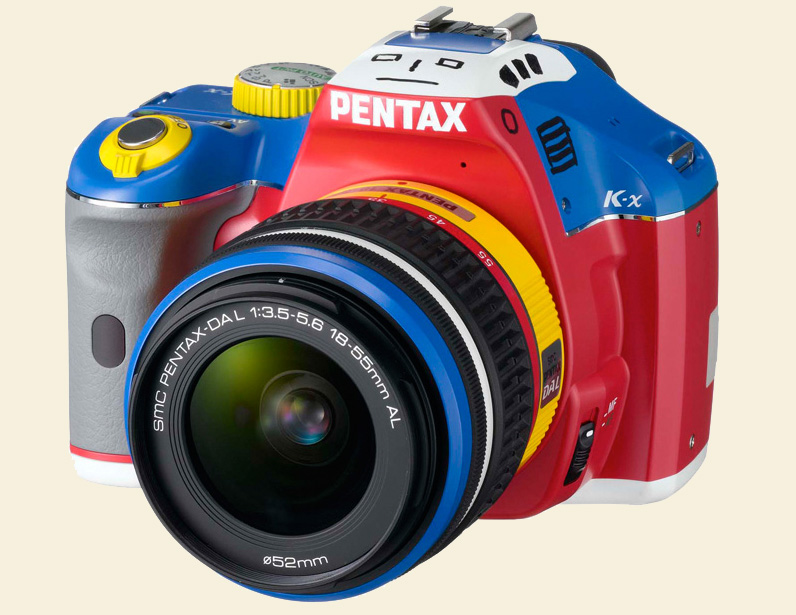Entirely by chance, both Ctein and I, unbeknownst to each other, were writing short essays on the same topic at the same time. So I thought I'd put them up together. This wasn't planned, it just happened. I took the short term, existing-technology view of high ISOs, and Ctein (at least at the end of his piece) took the infinite-possibility, far future view; not even really contradictory, despite my indulgent "high noon" header....
-
Mike: Not Needy and Nothing If Not Conservative
I was rather surprised that the result to Wednesday's poll turned out to be a classic bell curve; I thought it might well be an infinitely-rising curve, with the most people choosing the highest number, or, in effect, "all the speed I can get."
So what was my own answer to the question "When you're shopping for a digital camera, what's your minimum standard for high ISO of good quality?" I chose ISO 1600. [I waffled between 400 and 800. —Ctein.] I'm not greedy. Not needy. My requirements are modest. And Lord knows I'm nothing if not conservative. (Big smile.)
The reason has its basis in pure empiricism, as usual. I've simply observed over the years that with every digital camera I've owned or used extensively, from the meanest digicam to the Nikon D700 and D3, no matter how good the high ISOs look, lower ISOs look better.
Don't get me wrong—I'm very grateful for the high-quality high ISO speeds we all now enjoy. I spent the first half-decade of my photographic life shooting a black-and-white film (Kodak Plus-X) that I rated at E.I. 80...and usually shot with a yellow filter! Speed was a constant...issue. And I distinctly remember a brief window in the early years of this millennium when digital image quality had caught up to film at low ISOs but not at high ones, and I'd encounter forum postings from pros saying that before switching to digital, they would have to hold out for high-ISO performance from digital that at least matched that of film.
That period sure didn't last for very long. Canon led the way, but very soon all digital cameras matched film’s best speed. And then exceeded it.
What I do today is simply shoot at the camera’s best ISOs, unless I can’t, in which case I shift to something higher. Doesn’t everybody?
For any given camera, as ISOs increase, image quality deteriorates. It’s not just a question of noise. Sharpness and resolution subtly degrade, as does the richness and purity of colors, dynamic range, and so on. Noise intrudes too, as everyone knows, but I suspect that people who say things like “quality is identical from 100 to 800” are looking only at noise, and nothing else. I’m not saying I can tell the difference between 640 and 500, but there are more differences than just noise over a three-stop ISO range with the cameras I’ve tried.
One exception is that shooting specifically for B&W conversion allows a real increase in usable ISOs. Partly because chroma noise isn’t an issue—and partly, I suspect, because I’m used to grain with B&W and it doesn’t bother me! Well, it doesn’t really bother me in color, either. Not nearly as much as it bothers some. If noise is pretty, I don't mind it.
Still, with image stabilization and reasonably fast lenses, I’ve found I almost never need more than 1600—and seldom that, although it’s luxurious to have that speed in reserve. With the Nikon D3, 1600 was fully usable and 3200 was a reasonable “in a pinch” speed. With the Panasonic GF1 (although I’ve just started using it and reserve the right to change my mind as I work more with raw files), I suspect that 800 is the top “fully usable” speed and 1600 is the “in a pinch” speed. Which is okay for a digicam—it’s a lot better than my now-ancient Sony F-707. ISO 400 was really well beyond that camera's comfort level.
I have no quarrel at all with those who want more and more high ISO speed. I have no doubt they need it. At some point, however, I suspect we’ll reach “market saturation” on high ISO speeds...it’s happened that way with many other marketing/technical parameters in the history of photo techniques, from film size to lens speed. The new D3s indicates that we probably aren’t there yet. I don’t know where the market will decide to stop, but, just personally, I’m good where we are now.
From our Wednesday poll, looks like a fair number of others are reaching that point too.
Mike
-
Ctein: I Was Built for Comfort, But I Could Live With Speed
In the thread on the Nikon D3S, quite a few folks expressed serious doubts about the value of such high speeds, arguing, in various forms, that there isn't much merit in trying to produce fine photographs under conditions where we cannot even clearly see what we're photographing. I take firm exception to that position.
Serious, high-quality, fine-grain low-light photography (in contrast to the push-processed, available-darkness kind) has been part of the canon since at least the 1930s. When I was a noob in college in the late '60s and entirely ignorant of that canon, I clearly remember the night I wondered, "Hey, what would happen if, instead of loading with Tri-X or 2475 Recording film and pushing the bejeezus out of it [as I was accustomed to doing in my reportage photography], I set up the tripod, loaded up with Pan-X and pull-processed a bit for range, and just let the exposures take as long as they needed to?"
WOW! Gorgeous! Completely changed my artistic direction. I very quickly mastered night photography, figuring out which slow films had the best reciprocity characteristics and what the compensations needed to be to get accurate results in both B&W and color with exposure times up to 40-50 minutes. I made this one just a few years after I started on this track.
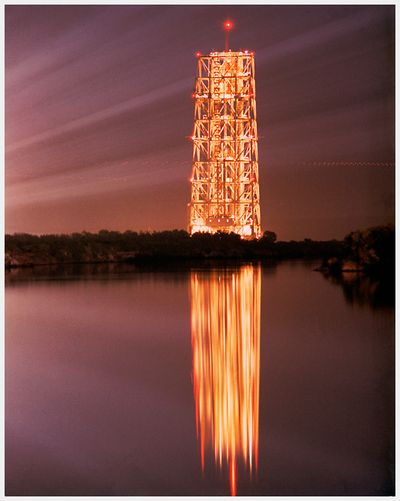
Ctein, Purple Gantry (original, with more accurate color, here)
In case you're wondering, no, I did not bracket. It sucked up enough of my life just making those 40-minute masterpieces. I made sure I got it right in one exposure. Carried a paperback and a flashlight in my bag; got a lot of reading done those nights. Metering? Meter off a highlight or a white sheet of paper and it's like boosting your meter sensitivity an order of magnitude. If I could see it, I could meter it. It went like this: meter would tell me I needed 2/3 second at ƒ/2 off of white paper. Okay, that's 5 seconds for a proper grey. Now start stopping down for depth of field. There I am at ƒ/13 for a photo like this one and the nominal exposure time's pushing over 200 seconds. The film I'm using's got a 10X reciprocity correction at 200 seconds. And so, it's reading time!
My first noteworthy bodies of work involved substantial amounts of just that kind of low-light photography (I never cared for Arthur Ollman's available-darkness "grain-o-graphs" when he showed up on the scene). That still includes some of my best photos. Two thirds of the photos in this screen required exposures of 30 seconds or more on slow film. I still routinely make multi-minute, low-light/ISO100-speed photographs (check out the Christmas in California series).
Digital sensors have better reciprocity characteristics, so my exposure times have dropped a lot the past few years; rarely do I need to go beyond a minute these days. Nonetheless, my style remains the same and the results are still artistically satisfying. Would I jump at ISO 100K? Not particularly; I'm okay with tripods and a couple of minutes between frames.
BUT...
There are lots of photos I don't make because the subject matter won't sit still for large numbers of seconds. Do I think having 1,000 times the ISO I now use would open up all sorts of artistic opportunities? Hell, yeah! Is it artistically, conceptually, and philosophically valid? Double-hell, yeah! Photography's never been merely about photographing what you could see; it's always been about photographing what you wanted to see.
Ctein
Send this post to a friend
